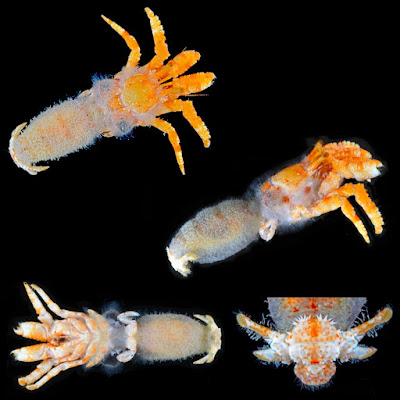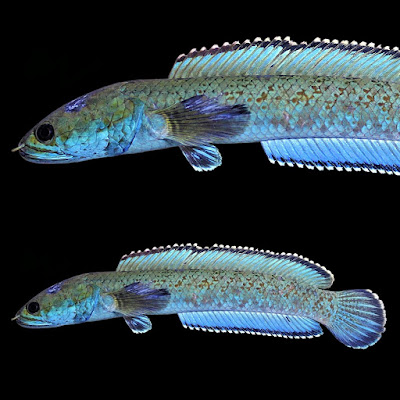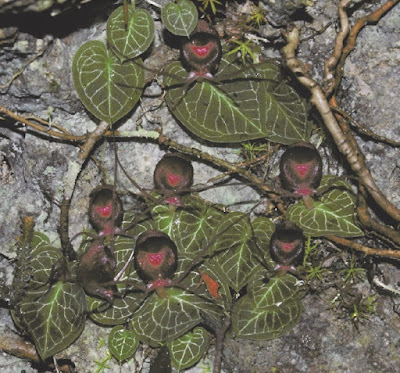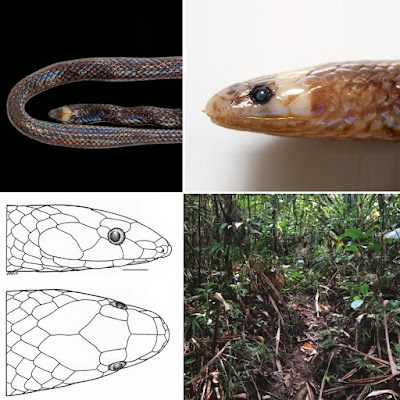[Most Recent Entries] [Calendar View]
Thursday, December 24th, 2020
| Time | Event | ||||
| 2:04a | [Crustacea • 2020] Cancellus heatherae • A New Species of the Hermit Crab Genus Cancellus H. Milne Edwards, 1836 (Decapoda: Diogenidae) from A Mesophotic Deep Bank in the northwestern Gulf of Mexico
Abstract Recent sampling on mesophotic deep banks in the northwestern Gulf of Mexico has produced a previously undescribed hermit crab assignable to the genus Cancellus H. Milne Edwards, 1836. Members of the genus are most often found to occupy cavities of eroded coral, siliceous sponges, porous calcareous rock fragments, algal concretions, or worm tubes as shelters. The present specimen was found loose as by-catch in a dredged rhodolith sample taken for algal life history studies. In situ, it likely occupied a cavity within one of the collected calcareous rhodoliths or small sponges in the by-catch. While our description is based on a single female specimen, the holotype is fully mature and intact, and it was solidly frozen in seawater until its coloration could be photographically documented and tissues extracted for sequencing. In comparison to the three other known western Atlantic species, the frontal rim of the carapace shield in the new species is continuous between the blunt lateral teeth as in C. ornatus Benedict, 1901 and C. viridis Mayo, 1873, and thus distinct from the subdivided front found in C. spongicola Benedict, 1901. The rim itself is somewhat flattened as in C. ornatus rather than inflated as in C. viridis. However, each of the ocular scales bears a pair of spines at the tip, as in C. viridis. The lower palms of the chelipeds, while distinctly rugose, do not have a separated patch of stridulating ridges comparable to those reported for C. spongicola. The yellow-orange to deep-orange pigmentation of the color pattern differs from fresh coloration in both C. ornatus and C. viridis, but that of C. spongicola is unknown for other than preserved specimens. Description of the single available specimen is in this case justified by the low likelihood for timely acquiring of additional samples from the type locality or adjacent habitats, most of which are deep banks warranting protection under pending habitat management changes. Our diagnosis includes GenBank accession numbers for COI sequences to facilitate future molecular phylogenetic comparisons. Keywords: Crustacea, new species, Anomura, Cancellus, mesophotic, Gulf of Mexico Taxonomy Family Diogenidae Genus Cancellus H. Milne Edwards, 1836 Cancellus heatherae n. sp. Diagnosis. Cephalothoracic shield width not exceeding length; rostrum well developed, angular, produced anteriorly beyond blunt anterolateral projections; narrow flattened frontal rim continuous across front between anterolateral projections, crossing rostrum without disjuncture; dorsal surface with angular depression on either side of shield posterior to rim behind each ocular peduncle. Median calcified plate of cardiac region subrectangular, slightly longer than wide. Ocular acicles armed with 2 spinules distally. Antennal acicle extending anteriorly less than onehalf length of ocular peduncle. Cheliped and second pereopod distal segments adapted to form operculum when withdrawn into habitat opening, outer surfaces of carpus and propodus with concave opercular depression. Cheliped propodus (palm) with opercular depression limited mesially by crest of 7 or 8 marginally denticulate lobes. Second pereopod propodus with opercular depression limited laterally by crest of 5 marginally denticulate lobes. Pleon elongate, with lightly sclerotized transverse tergites dorsally, 4 minute biramous pleopods on left side, depressed longitudinal groove along left side; sixth pleonite greatest width exceeding three-fourths greatest length, anterior lobes to either side of median incision each armed by 7 or 8 strong spines. Uropods and telson symmetrical; telson subovoid, anteriorly with subtriangular median dorsal prominence, posterior margin entire, unarmed except for setae. Color pattern of orange to yellow-orange dominating most dorsal surfaces and superior surfaces of anterior appendages, darker blotches and spots of deeper orange to reddish brown. A diagnostic COI gene sequence available under GenBank accession number MT800937. Etymology. This species name “heatherae” is chosen to honor Heather Bracken-Grissom for her extensive contributions to molecular phylogenetic studies of decapod crustaceans, including works focused on hermit crabs and other anomurans populating Gulf of Mexico waters. Her laboratory also generously made available the gene sequences here reported in our diagnosis. Habitat. The sole specimen was found among rhodoliths and other calcareous rubble on a mesophotic offshore bank at 95 m depth. Distribution. The species is known only from the type locality off Louisiana in the northwestern Gulf of Mexico, western Atlantic Ocean. Darryl L. Felder and Rafael Lemaitre. 2020. A New Species of the Hermit Crab Genus Cancellus H. Milne Edwards, 1836 from A Mesophotic Deep Bank in the northwestern Gulf of Mexico (Crustacea: Decapoda: Diogenidae). Zootaxa. 4890(4); 589–598. DOI: 10.11646/zootaxa.4890.4.10 | ||||
| 2:44a | [Ichthyology • 2020] Channa aristonei • A New Species of Snakehead (Teleostei: Channidae) from East Khasi Hills, Meghalaya, Northeastern India
Abstract A new species of colorful snakehead from Meghalaya, northeastern India is distinguished from all its congeners by possessing a uniform bright blue to bluish-green body, bright-blue dorsal, anal, and caudal fins, submarginally black with white distal margin, series of brown to maroon-red, rounded, oblong or clover-shaped blotches or spots on dorsolateral, postorbital, and ventrolateral region of head, continued on body forming oblique pattern or randomly distributed. The new species superficially resembles C. pardalis and C. bipuli in appearance, but it can be distinguished from both in having brown to maroon-red, rounded, oblong or clover-shaped blotches or spots on head and sides of the body (vs. possession of well-defined, black to brown, rounded to oblong spots), fewer pre-dorsal scales (7 vs. 8–9), more caudal-fin rays (15 vs. 13), and more vertebrae (49 vs. 45). The new species differs from both C. pardalis and C. bipuli by Kimura's two-parameter (K2P) distance of 4.2–4.8 and 4.9–6.0% in the coxI gene sequence. A key to the snakehead Gachua group of the Eastern Himalayan region is provided herein.
Channa aristonei Distribution and habitat.—Known from the streams at Puriang, East Khasi Hills, Meghalaya (Fig. 4). The habitat is a clear, slow-flowing hill stream, having rocky substrate, and Eriocaulon sp. as the only aquatic vegetation. The water temperature was 188C at the time of survey. Co-occurring species in the habitat were C. lipor, Danio meghalayensis, and Tor sp. Etymology.—This species is named after Aristone M. Ryndongsngi from Meghalaya, in recognition of his discovery of this new species and assistance to the authors during the field work. Jayasimhan Praveenraj, Tejas Thackeray, Sadokpam Gojendro Singh, Arumugam Uma, N. Moulitharan, and Bankit K. Mukhim. 2020. A New Species of Snakehead (Teleostei: Channidae) from East Khasi Hills, Meghalaya, Northeastern India. Copeia. 108(4); 938-947. DOI: 10.1643/CI2020007  | ||||
| 3:12a | [Botany • 2020] Corybas boholensis (Orchidaceae) • A New Jewel Orchid Species from Bohol Island, Central Visayas, Philippines
Abstract A new, critically endangered jewel orchid species, Corybas boholensis, is described and illustrated from forest over limestone on Bohol Island, Philippines. This diminutive species, belonging to the C. pictus complex, is distinct in having a deep red flower and a truncate, warty dorsal sepal with 9–11 veins at its widest point near the apex. This is the fifth species of Corybas recorded for the Philippines. Keywords: Monocots, Diurideae, Acianthinae, Malesia, karst, taxonomy, micro-endemic Corybas boholensis Tandang, R.Bustam. T. Reyes Jr. & S.P. Lyon Danilo N. Tandang, Tomas Jr. Reyes, Rene Alfred Anton Bustamante, John Rey C. Callado, Edwin R. Tadiosa, Esperanza Maribel Agoo and Stephanie P. Lyon. 2020. Corybas boholensis (Orchidaceae): A New Jewel Orchid Species from Bohol Island, Central Visayas, Philippines. Phytotaxa. 477(2); 261–268. DOI: 10.11646/phytotaxa.477.2.10 | ||||
| 9:31a | [Herpetology • 2020] Levitonius mirus • A New, Miniaturized Genus and Species of Snake (Cyclocoridae) from the Philippines
Abstract The Philippine archipelago is an exceptionally biodiverse region that includes at least 112 species of land snakes from 41 genera and 12 families. Recently, Cyclocoridae (formerly Lamprophiidae: Cyclocorinae) was proposed as a distinct, Philippine-endemic family, containing four genera: Cyclocorus, Hologerrhum, Myersophis, and Oxyrhabdium. Here, we describe an additional cyclocorid genus and species, Levitonius mirus, new genus and species, from Samar and Leyte Islands, Philippines. Molecular data support Levitonius, new genus, to be most closely related to Myersophis and Oxyrhabdium, and it shares multiple skeletal characteristics with these genera; Levitonius, new genus, differs from all of these taxa in body size, scalation, and other characters. Skeletal and other phenotypic data suggest that Levitonius, new genus, is fossorial and likely has a diet that is specialized on earthworms. Levitonius mirus, new genus and species, has a maximum total length of 172 mm and is at present the smallest known species in Elapoidea. Our results highlight the need for future work on Samar and Leyte Islands, which have received relatively little attention from systematists, in part because of a prevailing biogeographic paradigm that predicted (not necessarily correctly) that these islands would simply have a nested faunal subset of the Mindanao faunal region land vertebrates. The discovery of a strikingly distinct and phylogenetically divergent snake lineage on these landmasses joins numerous related studies calling for a wholesale reconsideration of the Pleistocene Aggregate Island Complex model (the PAIC paradigm of diversification) biogeographic framework. Levitonius, new genus Dwarf Burrowing Snakes Type species.— Levitonius mirus, new species. Diagnosis.— Members of the genus Levitonius can be distinguished by the possession of five supralabial scales, 15 longitudinal rows of dorsal scales throughout the length of the body, and subcaudal scales unpaired. Etymology.— The new generic appellation Levitonius is a masculine noun and a patronym in the genitive singular, honoring the numerous contributions and life-long dedication of Alan E. Leviton to the study of the systematics of Philippine snakes. Levitonius mirus, new species Waray Dwarf Burrowing Snake Diagnosis.— Levitonius mirus can be distinguished from all other SE Asian snake species by having the following combination of characters: small size (largest total length known 172.1 mm); five supralabial scales; 15 longitudinal rows of dorsal scales throughout length of body; subcaudal scales unpaired; pair of internasal scales present; anterior temporal scale present; preocular scale absent; loreal scale present, not in contact with eye; mental scale broadly in contact with anterior chin shields; scales smooth, iridescent; dorsum ground color may be light brown to nearly black; one pale transverse band present on posterior of head, crosses parietals, temporals, and posterior supralabials; pale midventral line present or absent. Distribution.— The new species is currently only known from Samar and Leyte Islands, southeastern Philippines. Etymology.— The species epithet mirus is a Latin adjective, meaning unexpected finding or surprise—a fitting specific epithet for the miniaturized, phylogenetically unique evolutionary lineage represented by the new genus and species described here. The suggested common name, the Waray Dwarf Burrowing Snake, honors the Waray-waray people of the eastern Visayas, in particular the Samareños who live in vicinity of the type locality, among the forested mountains of Samar Island, and the Leyteños who inhabit the new genus' only other documented locality in the montane forests of Leyte Island. Jeffrey L. Weinell, Daniel J. Paluh, Cameron D. Siler and Rafe M. Brown. 2020. A New, Miniaturized Genus and Species of Snake (Cyclocoridae) from the Philippines. Copeia. 108(4); 907-923. DOI: 10.1643/CH2020110 |
| << Previous Day |
2020/12/24 [Calendar] |
Next Day >> |
























